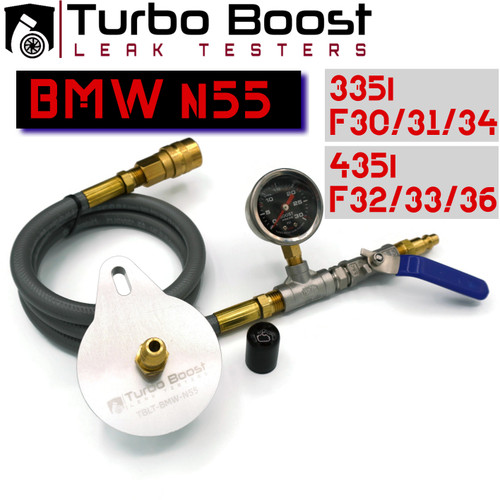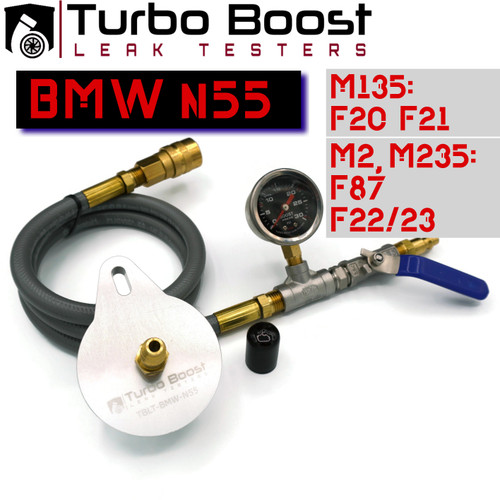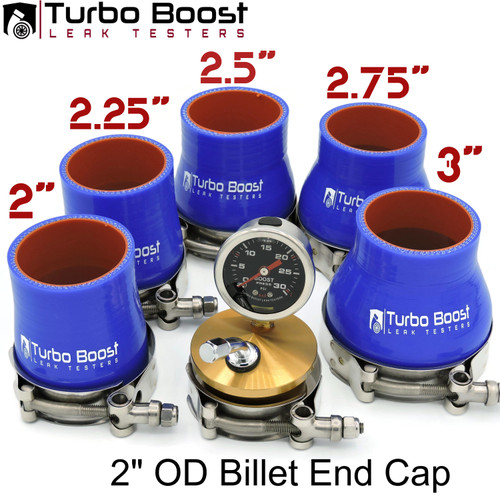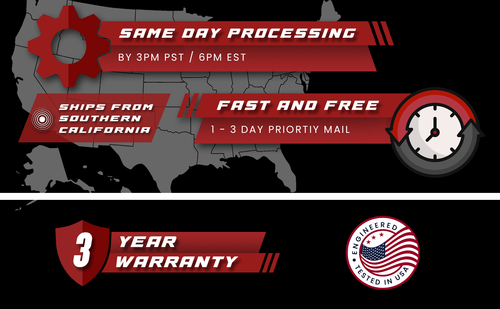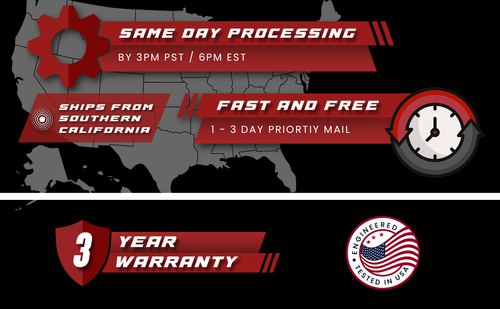Product Description
Have your piece of mind when spooling that turbo!
Testing your turbo motor charge path for leaks the correct way and keep the motor running healthy and boost with confidence! With the turbo buried between the slant I-6 motor and the frame rail, the last thing you want to do is swap a blown turbo from an avoidable boost leak.
This new release from Turbo Boost Leak Testers is the first and most effective way to pressure test all N55 F3x, F2X and F8X series engines to up to 30 PSI. The kit includes a bolt-on billet aluminum adapter that bolts directly on to the stock turbo with an extension hose, shut off valve and 30 PSI boost gauge to comfortably and safely apply pressure to the charge pipe system. This kit is designed to AVOID pressurizing the fragile N55 PCV system by testing right at the turbo inlet instead of anywhere before the turbo inlet.
This boost leak tester will pressurize the whole charge pipe path and detect any leaks from the turbo to the motor. This includes faulty diverter/bov's, clamped connections in the charge pipe, FMIC, intercooler connections, seals, hoses, and all connections at the intake manifold like vacuum and boost lines, injector o-rings... Basically everything the turbo normally pressurizes
Pressurizing the charge pipe system will allow you to run at the peak boost your motor was tuned for and ensure you are putting all the power down - without any leaks. A boost leak will cause the compressor wheels to over-spin to compensate for the lost pressure. This causes shaft play. Oil is super heated and causes the bearings to wear with more play. Left alone, this is what chews up the turbine and compressor wheels.
A boost leak test is a regular maintenance item that should be tested just like an oil change or replacing worn spark plugs. Clamps, pipes, rubber, seals all wear out! This is ever more important with motors tuned for higher boost and upgraded performance parts like FMIC’s, charge pipes, BOV, etc, because the charge path was tampered with and the turbo is being asked to make more boost than set from the factory. This causes a severe over spin.
This is why a tuner will, or should, always ask if you have had a boost leak test done. If not, it is strongly recommended to find a new tuner.
It's just a matter of time before a boost leak is present whether the motor has been tuned, parts swapped or upgraded or a motor running higher miles. It's an inevitable test that every turbo motor owner should do to keep the motor in good health and avoid costly repairs, especially if tuned, street racing or any track racing. Too many times we've seen customer cars come in thinking there aren't any boost leaks “i tightened all the clamps” or "it's been smoke tested" only to find some unexpected boost leaks in random places like torn injector o-rings, or flange seal. This throws off the tune, causes air fuel ratios to always be "chasing" for the loss in expected air, messes with ignition timing from increased air temps and reduces fuel economy. Another reason tuned motors running higher boost are at a higher risk of turbo over-spin to compensate for the leak AND the higher boost from the tune. This accelerates the turbo failure.
How to use this tester
Remove the turbo inlet pipe. Yes this is a bit tedious but unfortunately, required to properly test this N55 motor.
Here is an excellent video to show the removal of the inlet pipe - Youtube Search this “How to install the ALL NEW MST BMW N55 Inlet on my F30 335! Fits N55 135, 235, 335, 435“.
Remove the seal on the end of the intake pipe and install it on the boost leak tester end cap. Install the end cap on the turbo and bolt it down. Before pressurizing, install the provided rubber cap on the return air line as shown in the photos (rubber cap connects on the intake pipe exiting the airbox). Remove the oil cap! This vents any excess air in the crankcase or if there is an internal boost leak bleeding into the crankcase. Either way, remove the oil cap before pressurizing! Now, connect the extension hose with the quick connect fitting and set up your air compressor to a low pressure setting like 5 psi. Open the valve on the extension hose and pressurize up to 5 PSI. If it is not reaching the 5 PSI, turn up the compressor. The larger the difference between compressor and boost gauge indicates a larger leak. Tip: Shut the valve when the system is filled. The bleed down rate will indicate how well the system holds pressure. A 1 psi/second drop is normal. Now fix any leaks, and retest up to 10 PSI, and so forth. It's recommended not to exceed 20 PSI as any leaks will show up. Use soapy spray to identify small leaks.
Once you are able to hold pressure in the system with the valve off, there are no audible leaks, the oil cap is off and the crankcase is not being pressurized, then, you can be confident the charge path is solid.
Design Features & What's Included:
(1) Solid Billet 6061 Aluminum End Cap with ¼” NPT Air fitting
(1) 3 Ft Extension hose with stainless steel Custom 30 PSI Boost Gauge and stainless steel shut off valve
(1) Rubber cap for air line
Works on BMW N55 3.0L Engines from these chassis codes:
- 3-series 335i 335iX F30, F31, F34
- 4-series 435i 435iX and Gran Coupe F32, F33 & F36

















